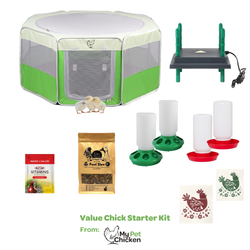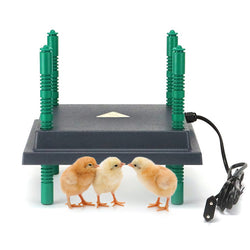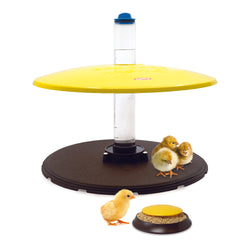Chicken Vent Gleet: An Icky, Sticky Problem
Back to blog
Our My Pet Chicken Flock Care Specialists receive health-related questions from y'all almost daily. A common question is about what appears to be a pasty butt in older chickens. In my experience, this is usually a case of "vent gleet," so I wanted to share what I know about it with you. A case of vent gleet, a.k.a. cloacitis, is a clear signal that your chickens' digestive system is out of whack. This is an icky, sticky topic for sure, but one that chicken keepers need to know about. It's more than unsightly—it's unhealthy— so you'll need to treat it, or risk your bird(s) dying.
Symptoms of Vent Gleet
The #1 symptom is a yellowish-white discharge from the vent area, which sticks to the feathers on the rear end. If you give your hen a bath and clean her all up, the same muck will promptly return due to the "stickiness" of this situation. The vent area may also be red and inflamed. And gleet... well, it reeks. No surprise there. In cases of late-stage or advanced vent gleet, your bird's abdomen will be firm, their vent will be very swollen and often even bloody.Preventing Vent Gleet
There are a few simple things you can do to prevent vent gleet in the first place.- Don't offer too many treats. Seriously. The bulk of your flock's diet should be a complete feed that you can pick up online, or less expensively at your local feed store. Keeping treats to a minimum helps make sure they aren't short on any vital vitamins or minerals that their treats may lack.
- Offer the proper feed for the age of your birds. Follow the manufacturer's feeding instructions. Typically, they recommend you offer starter feed up until 10-12 weeks of age, then move on to developer feed until around 20 weeks, followed by layer feed for your laying age hens and older.
- Always have grit (we recommend both chick grit and regular poultry grit, as flocks seem to love them both) on offer in cage cups like these. Our grit even includes probiotics to help with vent gleet! These products ensure your birds can properly move their food through their digestive tracts.
- Supplement water with anti-fungal, anti-bacterial products. I personally have my flock on the RopaPoultry Oregano Supplement, along with a lot of the staff here at My Pet Chicken.
- Offer your birds probiotics once a month or so.
Common Causes of Vent Gleet
PH balance of the cloaca — the cloaca is the canal into which the entire workings of your chicken's reproductive and digestive system empty. (Yes, chickens only have one orifice for all of that!) If your bird's PH balance is off, it will impair proper function, causing susceptibility to gleet. A fungal infection, like yeast — annoying, but usually not contagious. A bacterial infection — if your chicken has shown signs of gleet several weeks or months, and it won't clear up even after trying the usual treatments, it may be due to a bacterial infection. Stress or hormones — your flock's gut health can become unbalanced due to changes in the flock or their environment.
Treating vent gleet
Treating a case of vent gleet can take time and patience because you can't easily know the precise cause of the problem. You can take the bird to a vet—and for serious cases, you should do that immediately. For more mild cases, here's what we recommend you do:- Isolate the affected bird(s) from the rest of the flock while you are administering treatment.
- Offer fresh water daily, alternating adding probiotic and RopaPoultry Complete each day. Do this for the duration of their separation, making sure to administer following manufacturer instructions.
- Ensure they have access to both sizes of grit at all times.
- Clean the vent area daily, using a mild detergent such as Dawn dish soap, and warm water. Be sure to keep your bird adequately warm while drying, too—the stress of being cold won't help them recover! You may have to repeat this step for several days (a week or more) before it starts to clear up.
- Apply an over-the-counter anti-fungal cream around the vent area daily after washing.
Of course, every time you handle your bird, make sure to properly clean and sanitize your hands, and change your clothing if necessary. If your poor bird's infection doesn't clear after two weeks, you've got a more serious problem, and I recommend you take your bird to an avian vet immediately. The vet is likely to collect a fecal sample and prescribe an oral antibiotic.
In closing, an unhealthy booty = an unhealthy bird! Keep those butts healthy so you can show them off on Fluffy Butt Friday.






2 comments
I’ve been treating for vent gleet for 5 days noes. I soak in Epsom salt to remove the crusty and insert monistat inside and out around vent. Also mixing live cultured yogurt with her food and probiotics in water. Today her bum looks worse. Is this normal?
———
My Pet Chicken replied:
We are so sorry to hear that your hen hasn’t improved. Since we aren’t vets, we can only offer limited advice based on our experience.
It may take up to two weeks to see a complete reversal; make sure she is seperated from the rest of the flock and that she is calm and warm. Cleaning with a mild detergent like Dawn dish soap and warm water is the best method but be sure to completely dry her immediately after. (Many people use a hair dryer on low heat.) Alternating a probiotic in the water and RopaPoultry Complete while they are showing symptoms helps to treat from the inside while applying an anti-fungal cream to the vent on the outside gives a one-two punch to vent gleet!
If after 2 weeks she isn’t improving, we recommend taking your bird to an avian vet for further diagnosis. She may need further treatment including an antibiotic. We are crossing our fingers for both of you that this resolves quickly!
What can I do If my hen isn’t taking in anything. I put chick boost in her water but she is not drinking. I think she may be beyond help(?)she is an older bird not making eggs. I’ve washed her twice now but don’t know what else I can do.
———
My Pet Chicken:
I’m sorry to hear about your hen. Since we’re not vets, our advice is limited, but here are a few tips:
Isolation: Keep her in a warm, quiet place.
Hydration: Gently offer water with an eyedropper or syringe.
Food: Offer easily digestible food like scrambled eggs or plain yogurt.
Observe: Watch for specific symptoms to help with diagnosis.
Consult a Vet: If possible, see a poultry vet for professional advice.